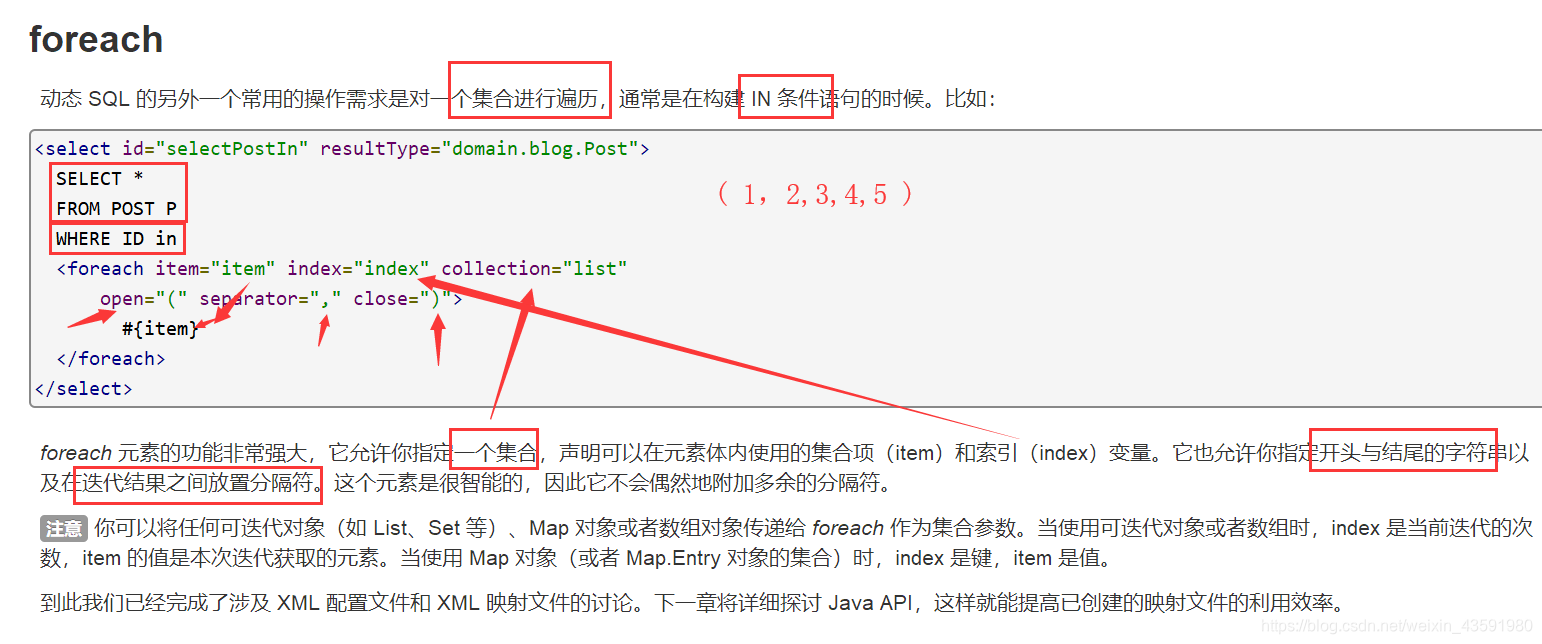什么是动态SQL:动态SQL就是指根据不同的条件生成不同的SQL语句
利用动态 SQL 这一特性可以彻底摆脱这种痛苦。
动态 SQL 元素和 JSTL 或基于类似 XML 的文本处理器相似。在 MyBatis 之前的版本中,有很多元素需要花时间了解。MyBatis 3 大大精简了元素种类,现在只需学习原来一半的元素便可。MyBatis 采用功能强大的基于 OGNL 的表达式来淘汰其它大部分元素。
if
choose (when, otherwise)
trim (where, set)
foreach
@Data
public class Blog {
private String id;
private String title;
private String author;
private Date createTime;
private int views;
}
编写实体类对应的Mapper接口和Mappe.xml文件
ID工具类:UUID生产随机数
public class IdUtils {
public static String getId(){
return UUID.randomUUID().toString().replaceAll("-","");
}
@Test
public void test(){
System.out.println(IdUtils.getId());
}
}
List<Blog> queryBlogIf(Map map);
<select id="queryBlogIf" parameterType="map" resultType="Blog">
select * from blog where 1=1
<if test="title != null">
and title = #{title}
</if>
<if test="author != null">
and author = #{author}
</if>
</select>
j@Test
public void testQueryBlogIf(){
SqlSession sqlSession = MybatisUtils.getSqlSession();
BlogMapper mapper = sqlSession.getMapper(BlogMapper.class);
HashMap map = new HashMap();
map.put("title","Java");
List<Blog> blogs = mapper.queryBlogIf(map);
for (Blog blog : blogs) {
System.out.println(blog);
}
sqlSession.close();
}
List<Blog> queryBlogChoose(Map map);
<select id="queryBlogChoose" parameterType="map" resultType="Blog">
select * from blog
<where>
<choose>
<when test="title != null">
title = #{title}
</when>
<when test="author != null">
and author = #{title}
</when>
<otherwise>
and views = #{views}
</otherwise>
</choose>
</where>
</select>
@Test
public void testQueryBlogChoose(){
SqlSession sqlSession = MybatisUtils.getSqlSession();
BlogMapper mapper = sqlSession.getMapper(BlogMapper.class);
HashMap map = new HashMap();
map.put("title","Java");
//map.put("author", "saxon");
map.put("views", 9);
List<Blog> blogs = mapper.queryBlogChoose(map);
for (Blog blog : blogs) {
System.out.println(blog);
}
sqlSession.close();
}
*where*元素只会在子元素返回任何内容的情况下才插入 “WHERE” 子句。而且,若子句的开头为 “AND” 或 “OR”,*where* 元素也会将它们去除。
如果 *where* 元素与你期望的不太一样,你也可以通过自定义 trim 元素来定制 *where* 元素的功能。比如,和 *where* 元素等价的自定义 trim 元素为:
<trim prefix="WHERE" prefixOverrides="AND |OR ">
...
</trim>
来看看与 *set* 元素等价的自定义 *trim* 元素吧:
<trim prefix="SET" suffixOverrides=",">
...
</trim>
注意,我们覆盖了后缀值设置,并且自定义了前缀值。
//更新博客
int updateBlog(Map map);
<update id="updateBlog" parameterType="map">
update blog
<set>
<if test="title != null">
title = #{title},
</if>
<if test="author != null">
author = #{author}
</if>
</set>
where id = #{id}
</update>
@Test
public void testUpdateBlog(){
SqlSession sqlSession = MybatisUtils.getSqlSession();
BlogMapper mapper = sqlSession.getMapper(BlogMapper.class);
HashMap map = new HashMap();
map.put("title","Java2");
map.put("author", "saxon");
map.put("id", "66ba951820b5435fab8acbcbf2ff824a");
mapper.updateBlog(map);
sqlSession.close();
}
<sql id="if-title-author">
<if test="title != null">
title = #{title},
</if>
<if test="author != null">
author = #{author}
</if>
</sql>
<update id="updateBlog" parameterType="map">
update mybatis.blog
<set>
<include refid="if-title-author"/>
</set>
where id = #{id}
</update>
select * from user where 1=1 and
<foreach item="id" collection="ids"
open="(" separator="or" close=")">
#{id}
</foreach>
(id=1 or id=2 or id=3)

<!--
select * from mybatis.blog where 1=1 and (id=1 or id = 2 or id=3)
我们现在传递一个万能的map , 这map中可以存在一个集合!
-->
<select id="queryBlogForeach" parameterType="map" resultType="blog">
select * from blog
<where>
<foreach collection="ids" item="id" open="and (" close=")" separator="or">
id = #{id}
</foreach>
</where>
</select>
动态SQL就是在拼接SQL语句,我们只要保证SQL的正确性,按照SQL的格式,去排列组合就可以了
建议:
原文:https://www.cnblogs.com/saxonsong/p/14884711.html